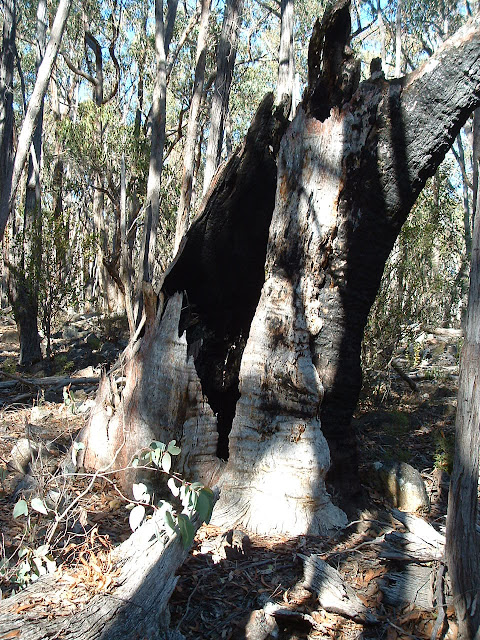This is probably where the Aboriginals have cut a carrier out of the bark.
What do you think Dave?
A good place to shelter out of the winter wind.
Another good shelter. Room in the log for your pack, and a place for a fire out front. What more could you ask for.
Beware of widow makers, especially when the wind is blowing.
Looking down into Hazard Valley from the trail.
Pilot Rock is in sight at last.
On top of Pilot Rock. I placed the small tree across the shoot some years ago, in case someone should slip!
View from the top of Pilot Rock. Pretty high up here.
There is shelter for one under this rock overhang at the bottom of Pilot Rock.
Room for another person to shelter here.
I follow the path round the base of Pilot Rock and back up the other side.
The trail can be a little treacherous going back down, especially with a pack on your back and carrying a gun. It pays to take your time and place your steps carefully.
Another view looking down into the valley.
Something has been digging this hollow log out recently since the last rain.















4 comments:
Great stuff...thank you. The dirt road where I am living now was once a popular place for the local Indians to live...henceforth the road is called Indian Springs Rd. It still amazes me at times to feel their spirit as I walk around here. Yes I truly can imagine what it was like for them.
Good to hear from you Diane, and thanks for the feedback. It must be great to live where you do.
Regards.
G'day Le Loup,
I enjoyed the post and the walk through your 'neck of the woods', the pictures were great. I would stamp both those trees as 'Aboriginal scarred Trees'. The first scar appears to be very old. Different species of eucalyptus display different edges when they heal. I would like to know the species.
Unless the scar was from a large branch, I would say that the scar probably caused the tree's death.
Not right away, but slowly. I say this because the interior is hollow (insects, decay whatever) and the obvious entry to do this
was via the exposed sapwood revealed by the removal of the bark.
The burnt stump has the signs of a scar at the base of the tree where the tree has tried to 'heal' itself. With a little (probably a fair bit) of imagination you can imagine the pointed oblong shape of a native shield. Well I can anyway.
I reckon people should realise that in a survival situation bark can (and has been for thousands of years)useful as a robust shelter. The first settlers of Australia stripped (ringbarked and later destroyed) thousands of trees for use in bark huts until they could get themselves organised with slab huts.
Sorry to ramble, I am learning a lot from your site, Cheers, Canberra Dave
Dave, what a great reply, please feel free to ramble anytime!
Thank you.
Regards.
Post a Comment